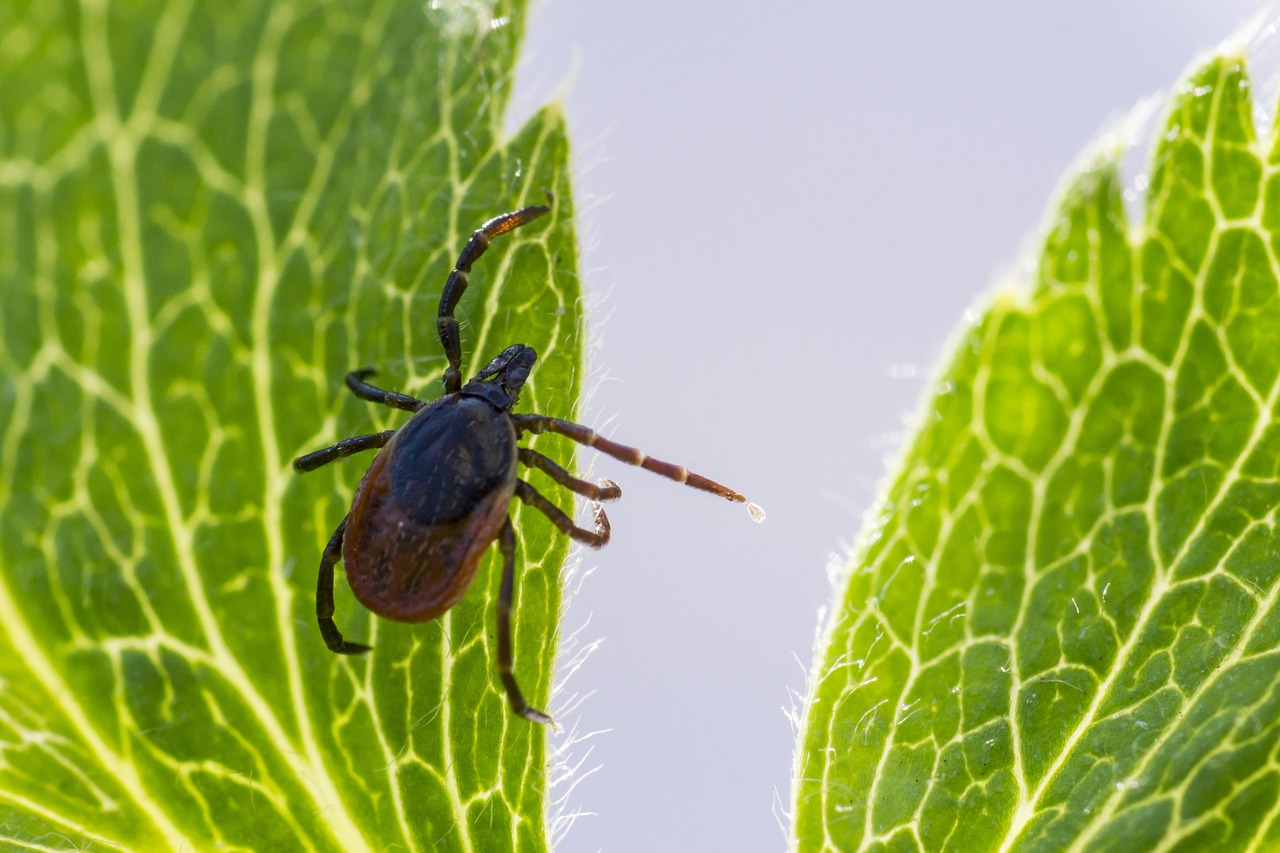Climate Change and the Escalation of Tick-borne Diseases
In recent years, the world has witnessed a dramatic shift in climate patterns, and with it, a troubling rise in tick-borne diseases. You might be wondering, what’s the connection? Well, as our planet warms, ticks are not only surviving but thriving in areas where they once struggled to exist. This relationship between climate change and the proliferation of diseases like Lyme disease and Rocky Mountain spotted fever is complex yet fascinating. It’s a bit like watching a suspenseful movie unfold—each scene revealing more about how our environment is changing and the impact it has on our health.
Ticks are often overlooked, but they are small creatures with a big impact. They are carriers of various pathogens that can cause serious health issues in humans. As temperatures rise, these tiny arachnids are expanding their territories, moving into regions previously deemed inhospitable. This means that more people are now at risk of encountering ticks and the diseases they carry. The stakes are high, and understanding this dynamic is crucial for implementing effective public health strategies.
Moreover, the changing climate is not just about warmer temperatures; it also involves altered precipitation patterns, which can create ideal conditions for tick populations to flourish. For instance, wetter conditions can lead to more vegetation, providing ticks with ample places to hide and thrive. It's a perfect storm where environmental changes lead to increased tick activity and, consequently, a heightened risk of tick-borne diseases.
As we delve deeper into this topic, we must also consider the broader implications for public health. The geographic expansion of ticks means that communities once considered safe from tick-borne diseases may now find themselves grappling with new health threats. This change necessitates a shift in how we educate and prepare communities, ensuring that everyone is aware of the risks and knows how to protect themselves.
Additionally, certain populations are more vulnerable than others. Outdoor workers, children, and those living in rural areas are at an increased risk of tick exposure. By identifying these groups, we can tailor our prevention efforts more effectively, ensuring that educational campaigns reach those who need it most. It's like gearing up for a big game; knowing your opponent's weaknesses can help you strategize better.
In conclusion, the interplay between climate change and tick-borne diseases is a pressing public health concern that requires immediate attention. As we continue to navigate this changing landscape, it is imperative to stay informed and proactive. By understanding the risks and implementing effective prevention strategies, we can mitigate the impact of tick-borne diseases on our communities.
- What are tick-borne diseases? Tick-borne diseases are illnesses transmitted to humans through the bite of infected ticks, such as Lyme disease and Rocky Mountain spotted fever.
- How does climate change affect ticks? Climate change leads to warmer temperatures and altered precipitation patterns, creating favorable conditions for ticks to thrive and expand their geographic range.
- Who is most at risk for tick exposure? Vulnerable populations include outdoor workers, children, and individuals living in rural areas where ticks are more prevalent.
- What can I do to protect myself from tick bites? Personal protection strategies include wearing appropriate clothing, using insect repellent, and performing tick checks after outdoor activities.

Understanding Tick-borne Diseases
Tick-borne diseases represent a significant public health concern, transmitted primarily through the bites of infected ticks. These minuscule arachnids are not just pesky nuisances; they can carry a plethora of pathogens that lead to serious health issues in humans. Among the most notorious tick-borne diseases are Lyme disease and Rocky Mountain spotted fever, both of which can have debilitating effects if not diagnosed and treated promptly.
Understanding the transmission of these diseases is crucial. Ticks feed on the blood of their hosts, which can include humans, pets, and wildlife. When an infected tick bites, it can transfer bacteria or viruses into the bloodstream, leading to a range of symptoms that vary from mild to severe. For instance, Lyme disease often starts with a characteristic bull's-eye rash and can progress to fatigue, joint pain, and neurological complications if left untreated.
Rocky Mountain spotted fever, on the other hand, can present with symptoms such as fever, headache, and a rash that may develop into more serious conditions like organ failure. The impact of these diseases on human health is profound, not just in terms of physical symptoms but also in the emotional and financial toll they can take on individuals and families. The long-term effects of tick-borne diseases can linger for years, leading to chronic health issues and a diminished quality of life.
To effectively combat tick-borne diseases, it is essential to understand their transmission dynamics, symptoms, and the populations most at risk. For instance, outdoor enthusiasts, hikers, and those who work in wooded or grassy areas are particularly vulnerable. Additionally, children, due to their curiosity and tendency to play in nature, are also at heightened risk. This understanding allows for tailored prevention strategies that can significantly reduce the incidence of these diseases.
In light of the rising incidence of tick-borne diseases, public health initiatives are increasingly focusing on education and awareness. This includes informing the public about the signs and symptoms of these diseases, the importance of early diagnosis, and the need for preventive measures. By fostering awareness, communities can work together to minimize the risks associated with tick encounters and protect vulnerable populations.
- What are common symptoms of tick-borne diseases? Symptoms can vary but often include fever, rash, fatigue, and joint pain.
- How can I protect myself from tick bites? Wearing long sleeves, using insect repellent, and performing tick checks after outdoor activities are effective strategies.
- Are all ticks dangerous? Not all ticks carry diseases, but it’s best to treat all tick bites with caution.

The Role of Climate Change
Climate change is more than just a buzzword; it's a reality that is reshaping our planet and, quite literally, the way we live. One of the most alarming consequences of this global phenomenon is its profound impact on tick populations and the diseases they carry. As the climate warms, we are witnessing a shift in the habitats that these pesky little creatures can thrive in, leading to an alarming rise in tick-borne diseases.
To understand this relationship, we need to consider two main factors: temperature and precipitation. Warmer temperatures create an inviting environment for ticks, allowing them to expand their geographic range. This means that areas previously considered unsuitable for tick survival, such as northern regions or higher altitudes, are now becoming prime real estate for these blood-sucking arachnids. In fact, studies have shown that tick populations are migrating northward at an alarming rate, with some species now found in regions where they were virtually nonexistent just a few decades ago.
But it’s not just the warmth that’s driving this change. Altered precipitation patterns also play a critical role. Ticks thrive in moist environments, and changes in rainfall can create ideal conditions for their survival and reproduction. For instance, increased rainfall can lead to more vegetation, providing ticks with the cover they need to hide from predators and wait for unsuspecting hosts. As a result, areas that experience heavy rainfall may see a surge in tick populations, further exacerbating the risk of disease transmission.
Now, let's break it down a bit further. Here’s a table summarizing the main environmental changes and their effects on tick populations:
| Environmental Change | Effect on Ticks |
|---|---|
| Warmer Temperatures | Increased survival rates and expanded geographic range |
| Increased Precipitation | More favorable habitats and higher reproductive rates |
| Longer Seasons | Extended periods of tick activity and increased human exposure |
This shift in tick populations is not just a theoretical concern; it has real-world implications for public health. As ticks invade new territories, the risk of diseases like Lyme disease and Rocky Mountain spotted fever rises dramatically. Communities that were once considered low-risk are now facing increased rates of infection, which puts additional pressure on healthcare systems and necessitates a shift in public health strategies.
In summary, the role of climate change in the escalation of tick-borne diseases cannot be overstated. As we continue to witness the effects of a warming planet, it becomes increasingly crucial for individuals and communities to understand the implications of these changes. Awareness and proactive measures can make a significant difference in mitigating the risks associated with tick encounters.
- How does climate change affect tick populations? Climate change leads to warmer temperatures and altered precipitation patterns, creating favorable conditions for ticks to thrive and expand their geographic range.
- What are some common tick-borne diseases? Common tick-borne diseases include Lyme disease, Rocky Mountain spotted fever, and anaplasmosis.
- How can I protect myself from tick bites? Wearing appropriate clothing, using insect repellent, and performing tick checks after outdoor activities are effective personal protection strategies.
- Are certain populations more vulnerable to tick exposure? Yes, outdoor workers, children, and individuals living in or visiting areas with high tick populations are at increased risk.

Geographic Expansion of Ticks
The phenomenon of is not just a passing trend; it's a significant shift that we need to pay attention to. As the planet's temperature rises, ticks are not just sitting idly by; they are moving into new territories, often surprising those who thought they were safe from these pesky parasites. Imagine a neighborhood where families used to play freely in their backyards, only to find that the very grass they once enjoyed is now a breeding ground for ticks. This is the reality many are facing today.
Research indicates that the range of tick populations has been steadily increasing, especially in regions that were previously considered inhospitable for these creatures. For instance, areas in the northern United States and Canada, which experienced colder climates, are now seeing a rise in tick activity. This expansion is fueled by several factors:
- Warmer Temperatures: As temperatures rise, ticks are able to survive and reproduce in areas where they previously could not.
- Changing Precipitation Patterns: Increased rainfall and humidity create ideal conditions for ticks to thrive.
- Human Encroachment: Urban development often leads to habitat fragmentation, pushing ticks closer to human populations.
One of the most concerning aspects of this expansion is the increased risk of disease transmission. When ticks migrate into new areas, they bring with them the potential for spreading diseases like Lyme disease and Rocky Mountain spotted fever. Communities that were once low-risk are now finding themselves in the crosshairs of these health threats. It's like opening Pandora's box; once ticks establish a foothold, it's incredibly challenging to control their spread.
Moreover, the geographic expansion of ticks isn't just limited to rural or wooded areas. Urban and suburban regions are also becoming hotspots for tick activity. This is particularly alarming as more people engage in outdoor activities, such as hiking, biking, and even gardening, putting them at greater risk of tick bites. The combination of human activity and the ticks' expanding range creates a perfect storm for public health concerns.
To illustrate the impact, consider the following table that highlights the increase in reported cases of tick-borne diseases in various regions over the past decade:
| Region | 2010 Cases | 2020 Cases | % Increase |
|---|---|---|---|
| New England | 3,000 | 14,000 | 366% |
| Mid-Atlantic | 2,500 | 10,000 | 300% |
| Upper Midwest | 1,200 | 5,500 | 358% |
As shown in the table, the increase in tick-borne disease cases is alarming. This is not just a statistic; it's a wake-up call for everyone. Communities need to be aware of the risks and take proactive measures to protect themselves. The more we understand about the geographic expansion of ticks, the better we can prepare for the challenges ahead. So, what can we do? Creating awareness and implementing effective prevention strategies are crucial steps in combating this growing public health issue.

Impact on Public Health
The emergence of tick-borne diseases as a significant public health concern is largely attributed to the changing climate. As ticks expand their territories into regions previously deemed safe, the potential for increased human exposure grows. This shift is not just a minor inconvenience; it poses serious health risks that can affect individuals and communities alike. The rise in tick populations can lead to a surge in diseases such as Lyme disease, Rocky Mountain spotted fever, and others, which can have debilitating effects on those infected.
Moreover, the symptoms associated with these diseases can vary widely, often leading to misdiagnosis. Lyme disease, for instance, may initially present as flu-like symptoms, which can easily be overlooked. If left untreated, it can progress to more severe complications such as arthritis, neurological issues, and even heart problems. This complexity underscores the necessity for greater public awareness and education regarding tick-borne diseases.
In addition to direct health impacts, the spread of tick-borne diseases places a strain on healthcare systems. Increased cases lead to higher medical costs, more hospital visits, and a greater demand for healthcare resources. This can overwhelm local health services, particularly in rural areas where resources may already be limited. As such, it is crucial for public health officials to monitor tick populations and disease incidence closely, ensuring that preventive measures are in place to protect vulnerable communities.
The impact of tick-borne diseases is not uniform; it disproportionately affects certain populations. For instance, outdoor workers—such as farmers, landscapers, and park rangers—are at heightened risk due to their frequent exposure to tick habitats. Similarly, children, who often play in grassy or wooded areas, are more susceptible to tick bites. Understanding these vulnerabilities is essential in tailoring effective public health interventions and educational campaigns aimed at reducing tick encounters.
To illustrate the growing concern, consider the following table that summarizes the most common tick-borne diseases, their symptoms, and potential long-term effects:
| Disease | Common Symptoms | Potential Long-term Effects |
|---|---|---|
| Lyme Disease | Fever, headache, fatigue, and a characteristic skin rash | Joint pain, neurological problems, heart issues |
| Rocky Mountain Spotted Fever | Fever, rash, headache, abdominal pain | Severe complications if untreated, including organ failure |
| Anaplasmosis | Fever, chills, muscle aches, and headache | Potential for severe illness if untreated |
As the climate continues to change, the relationship between environmental factors and public health becomes increasingly evident. The need for proactive measures to address this issue cannot be overstated. Communities must come together to share knowledge, resources, and strategies to combat the rising threat of tick-borne diseases. By fostering a culture of awareness and preparedness, we can better protect ourselves and future generations from the health risks posed by these resilient pests.
- What are the most common tick-borne diseases? The most common include Lyme disease, Rocky Mountain spotted fever, and anaplasmosis.
- How can I protect myself from tick bites? Wear long sleeves and pants, use insect repellent, and perform tick checks after outdoor activities.
- Are certain populations more at risk? Yes, outdoor workers and children are particularly vulnerable to tick exposure.
- What should I do if I find a tick on my body? Remove it promptly with tweezers, clean the area, and monitor for symptoms.

Vulnerable Populations
When we talk about tick-borne diseases, it's essential to recognize that not everyone is equally at risk. Certain groups of people are particularly vulnerable to tick bites and the diseases they carry. Outdoor workers, such as farmers, landscapers, and construction workers, often spend extended periods in areas where ticks thrive. Their likelihood of encountering ticks is significantly higher, making them prime candidates for infections like Lyme disease and Rocky Mountain spotted fever.
Moreover, children are another group that faces increased risk. Kids love to explore the great outdoors, whether it's through playing in the park, hiking, or camping. Their curiosity often leads them into tick-infested areas, and they may not be as aware of the precautions they should take. This lack of awareness can lead to higher exposure rates among children, making it crucial for parents and guardians to educate them about tick safety.
Additionally, elderly individuals and those with compromised immune systems are also at heightened risk. As we age, our immune systems may not respond as effectively to infections, increasing the severity of tick-borne diseases if contracted. Furthermore, those with chronic illnesses may find themselves more susceptible, as their bodies are already battling other health issues.
In light of these vulnerabilities, targeted prevention efforts are essential. Communities can implement educational campaigns tailored to these at-risk groups, providing them with the knowledge and tools to protect themselves. For example, outdoor workers can be trained on proper clothing and tick-check techniques, while parents can learn about the signs and symptoms of tick bites to watch for in their children.
In conclusion, recognizing and addressing the needs of vulnerable populations is critical in the fight against tick-borne diseases. By understanding who is most at risk and why, we can create effective strategies to safeguard these individuals and reduce the overall incidence of tick-related health issues.
- What are the symptoms of tick-borne diseases? Symptoms can vary, but common signs include fever, chills, fatigue, and rash. It's essential to seek medical attention if you suspect a tick-borne illness.
- How can I protect myself from ticks? Wear long sleeves and pants, use insect repellent, and perform tick checks after being outdoors.
- Are there specific areas where ticks are more prevalent? Yes, ticks thrive in wooded and grassy areas, particularly in regions with warm and humid climates.
- What should I do if I find a tick on my body? Remove it carefully with tweezers, ensuring you get the entire tick. Clean the bite area and monitor for any symptoms.

Seasonal Patterns
Climate change is not just about rising temperatures; it’s also about how these changes disrupt the natural rhythms of our environment, particularly when it comes to tick activity. As the seasons shift, ticks are responding in ways that can catch us off guard. For instance, warmer winters and earlier springs mean that ticks are waking up from their dormancy much sooner than they used to. This shift extends the tick season, allowing these pesky parasites to thrive for longer periods each year. Think of it like a clock that has been reset to chime earlier; the ticks are now more active when people are out enjoying the great outdoors.
The implications of these changes are significant. With longer active seasons, the window for potential tick exposure has widened. In the past, you might have felt safe hiking in the woods during the summer months, but now, with ticks becoming active in early spring and lingering into late fall, the risks are higher. This is especially concerning for outdoor enthusiasts, families, and anyone who spends time in nature. It’s like playing a game where the rules keep changing; you have to stay alert and adapt to the new reality.
Moreover, the life cycle of ticks is closely tied to seasonal patterns. Warmer temperatures can accelerate their development, meaning that ticks can reproduce more quickly and in greater numbers. For example, a single female tick can lay thousands of eggs, and if conditions are right, those eggs can hatch into larvae that are ready to feed sooner than expected. This exponential growth can lead to a surge in tick populations, which directly correlates with an increase in tick-borne diseases. It’s a cycle that feeds on itself, much like a wildfire that spreads rapidly when conditions are dry and windy.
To illustrate the impact of climate change on tick activity, consider the following table:
| Season | Typical Tick Activity | Impact of Climate Change |
|---|---|---|
| Winter | Low | Warmer winters lead to ticks remaining active longer. |
| Spring | Increasing | Earlier warming results in ticks becoming active sooner. |
| Summer | High | Extended season due to warmer temperatures. |
| Fall | Decreasing | Longer active season can extend into late fall. |
As we navigate these changes, it’s crucial to stay informed and vigilant. Understanding the seasonal patterns of tick activity can help us take proactive steps to reduce our risk of exposure. Whether it’s planning outdoor activities with the weather in mind or taking extra precautions during peak tick season, knowledge is our best defense against these tiny but mighty threats.
- What are the symptoms of tick-borne diseases? Symptoms can vary but often include fever, chills, fatigue, and rashes. It's important to seek medical attention if you suspect a tick-borne illness.
- How can I prevent tick bites? Wear long sleeves and pants, use insect repellent, and perform tick checks after outdoor activities.
- Are certain areas more prone to ticks? Yes, areas with dense vegetation and wildlife are typically at a higher risk for ticks.
- Can ticks survive in colder climates? While ticks prefer warmer environments, they can survive in colder climates by entering a dormant state.

Preventive Measures
When it comes to tackling the rising threat of tick-borne diseases, prevention is our best ally. Just like wearing a seatbelt protects you in a car, adopting effective preventive measures can significantly reduce the risk of tick encounters. It’s essential to arm yourself with knowledge and practical strategies to safeguard your health and that of your loved ones. So, what can you do to stay safe?
First and foremost, personal protection is key. Dressing appropriately when venturing into tick-prone areas is crucial. Imagine you’re going into a jungle; would you wear flip-flops and shorts? Of course not! Opt for long pants and long-sleeved shirts, preferably in light colors, which make it easier to spot ticks. Tucking your pants into your socks can provide an extra layer of defense, creating a physical barrier that ticks have to work harder to cross.
In addition to clothing, using insect repellent is a game-changer. Repellents containing DEET, picaridin, or oil of lemon eucalyptus are effective at keeping ticks at bay. Apply these products on exposed skin and clothing, following the manufacturer's instructions. It’s like putting up a “No Trespassing” sign for ticks – they’ll think twice before invading your space!
After enjoying the great outdoors, it’s vital to perform thorough tick checks. This simple act can be the difference between a fun day outside and a potential health scare. Check your body, especially warm and hidden areas such as behind the ears, under the arms, and behind the knees. Don’t forget to inspect your pets too! Ticks love to hitch a ride on furry friends, so giving them a good check can prevent bringing these unwanted guests into your home.
On a broader scale, community awareness programs play a significant role in combating tick-borne diseases. Educating the public about the risks associated with ticks and effective prevention methods can empower individuals to take proactive steps. Imagine a neighborhood where everyone is informed and vigilant; it creates a ripple effect of safety. Community workshops, informational flyers, and social media campaigns can spread awareness like wildfire, ensuring that no one is left in the dark about tick prevention.
Moreover, local governments and health organizations can collaborate to implement preventive measures in parks and recreational areas. Regular maintenance, such as clearing tall grass and brush, can help minimize tick habitats. A well-maintained park is not just a pretty sight; it's a safer place for families to enjoy nature without the lurking threat of ticks.
In summary, while the threat of tick-borne diseases is real, there are plenty of ways to protect yourself and your community. By combining personal protective strategies with community awareness, we can create a safer environment for everyone. Remember, prevention is not just an individual effort; it’s a collective one!
- What are the most common tick-borne diseases? Lyme disease, Rocky Mountain spotted fever, and anaplasmosis are among the most prevalent tick-borne diseases.
- How can I remove a tick safely? Use fine-tipped tweezers to grasp the tick as close to the skin's surface as possible. Pull upward with steady, even pressure. Clean the area afterward.
- What should I do if I find a tick on my pet? Consult your veterinarian for advice on tick removal and prevention products.
- Are all ticks dangerous? Not all ticks carry diseases, but it’s best to treat all ticks with caution and remove them promptly.

Personal Protection Strategies
When it comes to protecting yourself from tick bites, being proactive is key. It's essential to understand that ticks thrive in certain environments, particularly in wooded or grassy areas, so taking the right steps can make a significant difference. One of the most effective personal protection strategies is to wear appropriate clothing. This means opting for long sleeves and pants when venturing outdoors, especially in tick-prone areas. Tucking your pants into your socks can create a barrier that makes it more difficult for ticks to latch onto your skin. Think of it as building a fortress around yourself; the more layers you have, the harder it is for invaders to breach your defenses.
In addition to clothing, using insect repellent is a crucial tactic. Look for repellents that contain DEET, picaridin, or oil of lemon eucalyptus. These ingredients are known to be effective at keeping ticks at bay. When applying repellent, be sure to cover all exposed skin and even the outside of your clothing. It’s like applying sunscreen before hitting the beach; you want to ensure every part is protected. Remember, reapplication is important, especially if you’re sweating or spending extended periods outdoors.
After enjoying a day outside, performing a thorough tick check is vital. This means inspecting your body, especially areas where ticks are likely to hide, such as behind the ears, under the arms, and around the waist. Don’t forget to check your pets as well, as they can bring ticks into your home. If you find a tick, remove it carefully with tweezers, grasping it as close to the skin’s surface as possible. This process is crucial because the longer a tick is attached, the higher the risk of disease transmission.
Community awareness plays a significant role in personal protection as well. Engaging in local educational programs can empower you and your neighbors with knowledge about tick-borne diseases and prevention methods. When communities work together, they can create a safer environment for everyone. For instance, organizing neighborhood clean-up days can help reduce tick habitats by clearing brush and tall grasses where ticks like to hide. It’s a collective effort that not only protects individuals but also fosters a sense of community responsibility.
Ultimately, protecting yourself from ticks isn't just about individual actions; it's about creating a culture of awareness and prevention. By integrating these personal protection strategies into your outdoor routine, you can significantly reduce your risk of tick bites and the diseases they carry. Just like wearing a seatbelt while driving, these precautions can be the difference between safety and danger in the great outdoors.
- How can I tell if a tick is carrying a disease? Unfortunately, there is no way to determine if a tick is infected just by looking at it. The best approach is to take preventive measures and remove ticks promptly.
- What should I do if I find a tick on my body? Use fine-tipped tweezers to grasp the tick as close to the skin's surface as possible and pull upward with steady, even pressure. Clean the bite area and your hands with rubbing alcohol or soap and water.
- Are certain areas more prone to ticks? Yes, ticks are commonly found in wooded, grassy, or bushy areas. Be extra cautious in these environments, especially during warmer months.
- Can pets get ticks, and what should I do? Yes, pets can get ticks. Regularly check your pets for ticks and consult your veterinarian about tick prevention treatments.

Community Awareness Programs
Community awareness programs play a pivotal role in combating the rising threat of tick-borne diseases. These initiatives are designed to educate the public about the risks associated with ticks, how to recognize the signs of tick-borne illnesses, and the best practices for prevention. By fostering a well-informed community, we empower individuals to take proactive measures to protect themselves and their loved ones. Think of these programs as the community's first line of defense against the encroaching risk of tick-related health issues.
One effective way to raise awareness is through local workshops and seminars. These events can be hosted in schools, community centers, or even online, making it accessible for everyone. During these sessions, experts can share valuable information about tick habitats, life cycles, and the environmental changes that contribute to their proliferation. Participants can learn about the symptoms of common tick-borne diseases, such as Lyme disease and Rocky Mountain spotted fever, enabling them to seek medical attention promptly if they suspect an infection.
Additionally, distributing educational materials, such as brochures and flyers, can help reinforce the information shared in these programs. These materials should include practical tips on how to avoid tick bites, such as:
- Wearing light-colored clothing to make ticks easier to spot.
- Staying on trails when hiking to minimize contact with tall grass and brush.
- Using EPA-approved insect repellents on exposed skin and clothing.
Moreover, community awareness programs can also engage local schools to incorporate tick education into their health curriculum. This approach not only educates children but also encourages them to share this knowledge with their families, creating a ripple effect of awareness throughout the community.
To measure the effectiveness of these programs, communities can conduct surveys before and after the initiatives to assess changes in knowledge and behavior regarding tick safety. This data can help refine future programs and ensure they meet the community's needs effectively. Ultimately, the goal is to cultivate a culture of vigilance and preparedness, where individuals recognize the importance of taking simple yet effective steps to protect themselves from tick bites.
Q1: What are the most common tick-borne diseases?
A1: The most common tick-borne diseases include Lyme disease, Rocky Mountain spotted fever, and anaplasmosis, among others. Each of these diseases has distinct symptoms and requires different treatment approaches.
Q2: How can I tell if I have been bitten by a tick?
A2: Tick bites can sometimes go unnoticed, but you may notice a small red bump at the bite site. In some cases, ticks can transmit diseases, leading to symptoms such as fever, chills, and rash. It's crucial to check for ticks after spending time outdoors, especially in wooded or grassy areas.
Q3: What should I do if I find a tick on my body?
A3: If you find a tick, remove it promptly using fine-tipped tweezers. Grasp the tick as close to the skin's surface as possible and pull upward with steady, even pressure. Clean the bite area and your hands with rubbing alcohol or soap and water. If you develop symptoms after a tick bite, consult a healthcare professional.
Q4: Are there vaccines available for tick-borne diseases?
A4: Currently, there is no widely available vaccine for Lyme disease, but research is ongoing. Preventive measures, such as using repellents and wearing protective clothing, remain the best defense against tick bites.
Frequently Asked Questions
- What are tick-borne diseases?
Tick-borne diseases are illnesses transmitted to humans through the bites of infected ticks. Common examples include Lyme disease and Rocky Mountain spotted fever. Understanding these diseases is essential for effective prevention and treatment.
- How does climate change affect tick populations?
Climate change creates warmer temperatures and alters precipitation patterns, which can expand tick habitats. This means that ticks are moving into new areas, increasing the risk of tick-borne diseases in regions that were previously considered low-risk.
- Who is most at risk for tick exposure?
Certain groups, such as outdoor workers, hikers, and children, are at a higher risk of encountering ticks. Recognizing these vulnerable populations helps in tailoring prevention efforts and educational campaigns to effectively protect them.
- What preventive measures can I take to avoid tick bites?
To reduce the risk of tick bites, wear appropriate clothing, use insect repellent, and conduct tick checks after spending time outdoors. These personal protection strategies can significantly lower the chances of getting bitten.
- How can communities raise awareness about tick-borne diseases?
Community awareness programs play a vital role in educating the public about tick-borne diseases and prevention methods. By empowering individuals with knowledge, communities can take proactive steps to minimize tick encounters and enhance public health initiatives.
- What seasonal changes should I be aware of regarding ticks?
Climate change can lead to warmer winters and earlier springs, which may extend the active periods for ticks. Being aware of these seasonal patterns can help you take precautions during peak tick activity times.



















